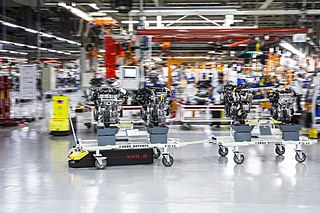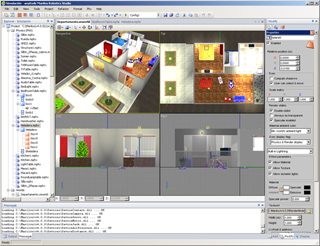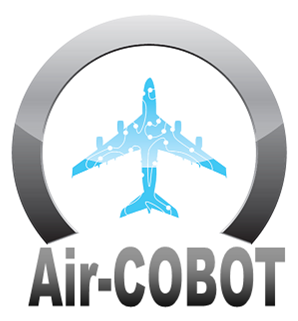A transducer is a device that converts energy from one form to another. Usually a transducer converts a signal in one form of energy to a signal in another. Transducers are often employed at the boundaries of automation, measurement, and control systems, where electrical signals are converted to and from other physical quantities. The process of converting one form of energy to another is known as transduction.

ASIMO is a humanoid robot created by Honda in 2000. It is displayed in the Miraikan museum in Tokyo, Japan. On 8 July 2018, Honda posted the last update of Asimo on their official page stating that it would be ceasing all development and production of Asimo robots in order to focus on more practical applications using the technology developed through Asimo's lifespan. It made its last active appearance in March 2022, over 20 years after its first, as Honda announced that they are retiring the robot to concentrate on remote-controlled, avatar-style, robotic technology.
Robotic mapping is a discipline related to computer vision and cartography. The goal for an autonomous robot is to be able to construct a map or floor plan and to localize itself and its recharging bases or beacons in it. Robotic mapping is that branch which deals with the study and application of ability to localize itself in a map / plan and sometimes to construct the map or floor plan by the autonomous robot.

Wakamaru is a Japanese robot made by Mitsubishi Heavy Industries that is intended to perform natural communication with human beings. The yellow, 3-foot domestic robot debuted in 2005 at a $14,300-$15,000 USD price-point exclusively for Japanese households. Through its development, the Wakamaru has been used for presenting at exhibitions, guiding customers, and working as a desk receptionist. However, the Wakamaru has not advanced beyond its first model that was released in 2005.

The Electrolux Trilobite is a robotic vacuum cleaner manufactured by the Swedish corporation Electrolux. It takes its name from the extinct arthropod, which scoured the ocean's floor.

The PaPeRo which stands for "Partner-type-Personal-Robot", is a personal robot developed by Japanese firm NEC Corporation. It is noted for its cute appearance and facial recognition system. The robot's development began in 1997 with the first prototype, the R100. The name PaPeRo was adopted in 2001.

An automated guided vehicle (AGV), different from an autonomous mobile robot (AMR), is a portable robot that follows along marked long lines or wires on the floor, or uses radio waves, vision cameras, magnets, or lasers for navigation. They are most often used in industrial applications to transport heavy materials around a large industrial building, such as a factory or warehouse. Application of the automatic guided vehicle broadened during the late 20th century.
RAVON is a robot being developed at the Robotics Research Lab at University of Kaiserslautern, Germany. The vehicle is used, as a testbed to investigate behaviour-based strategies on motion adaptation, localization and navigation in rough outdoor terrain. The basis vehicle was produced by Robosoft.

IvanAnywhere is a simple, remote-controlled telepresence robot created by Sybase iAnywhere programmers to enable their co-worker, Ivan Bowman, to efficiently remote work. The robot enables Bowman to be virtually present at conferences and presentations, and to discuss product development with other developers face-to-face. IvanAnywhere is powered by SAP's mobile database product, SQL Anywhere.

The e-puck is a small (7 cm) differential wheeled mobile robot. It was originally designed for micro-engineering education by Michael Bonani and Francesco Mondada at the ASL laboratory of Prof. Roland Siegwart at EPFL. The e-puck is open hardware and its onboard software is open-source, and is built and sold by several companies.
FemiSapien is a female humanoid robot that WowWee announced at CES in January 2008. It can respond to sight, sound, and touch and can be programmed with a sequence of movements. At CES 2008 an estimated release date of late summer and $99 MSRP were given, and was being sold for $89.99 in 2009.

anyKode Marilou is a modeling and simulation environment for mobile robots, humanoids, articulated arms and parallel robots operating in real-world conditions that respect the laws of physics. This robotics suite is used in research centers and industry for various projects like humanoid architectures, wheeled and multi legged vehicles, and multi-robot systems (Multi-agents).

A time-of-flight camera, also known as time-of-flight sensor, is a range imaging camera system for measuring distances between the camera and the subject for each point of the image based on time-of-flight, the round trip time of an artificial light signal, as provided by a laser or an LED. Laser-based time-of-flight cameras are part of a broader class of scannerless LIDAR, in which the entire scene is captured with each laser pulse, as opposed to point-by-point with a laser beam such as in scanning LIDAR systems. Time-of-flight camera products for civil applications began to emerge around 2000, as the semiconductor processes allowed the production of components fast enough for such devices. The systems cover ranges of a few centimeters up to several kilometers.

In computing, an input device is a piece of equipment used to provide data and control signals to an information processing system, such as a computer or information appliance. Examples of input devices include keyboards, computer mice, scanners, cameras, joysticks, and microphones.

Robotino is a mobile robot system made by Festo Didactic, and used for educational, training and research purposes.

LAURON is a six-legged walking robot, which is being developed at the FZI Forschungszentrum Informatik in Germany. The mechanics and the movements of the robot are biologically-inspired, mimicking the stick insect Carausius Morosus. The development of the LAURON walking robot started with basic research in field of six-legged locomotion in the early 1990s and led to the first robot, called LAURON. In the year 1994, this robot was presented to public at the CeBIT in Hanover. This first LAURON generation was, in contrast to the current generation, controlled by an artificial neural network, hence the robot's German name: LAUfROboter Neuronal gesteuert. The current generation LARUON V was finished in 2013.

Justin is an autonomous and programmable humanoid robot with two arms, developed by the German Aerospace Center (DLR) at the Institute of Robotics and Mechatronics, located in Wessling, Germany. Introduced in 2009, this wireless robot is controllable through telepresence, a type of technology that allows a person to feel as if they were present from a location other than their true location.

Air-Cobot (Aircraft Inspection enhanced by smaRt & Collaborative rOBOT) is a French research and development project of a wheeled collaborative mobile robot able to inspect aircraft during maintenance operations. This multi-partner project involves research laboratories and industry. Research around this prototype was developed in three domains: autonomous navigation, human-robot collaboration and nondestructive testing.

A high performance positioning system (HPPS) is a type of positioning system consisting of a piece of electromechanics equipment (e.g. an assembly of linear stages and rotary stages) that is capable of moving an object in a three-dimensional space within a work envelope. Positioning could be done point to point or along a desired path of motion. Position is typically defined in six degrees of freedom, including linear, in an x,y,z cartesian coordinate system, and angular orientation of yaw, pitch, roll. HPPS are used in many manufacturing processes to move an object (tool or part) smoothly and accurately in six degrees of freedom, along a desired path, at a desired orientation, with high acceleration, high deceleration, high velocity and low settling time. It is designed to quickly stop its motion and accurately place the moving object at its desired final position and orientation with minimal jittering.














